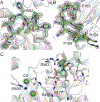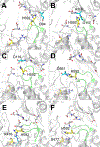Crystal Structure and Conformational Dynamics of Pyrococcus furiosus Prolyl Oligopeptidase
- PMID: 30786206
- PMCID: PMC6714975
- DOI: 10.1021/acs.biochem.9b00031
Crystal Structure and Conformational Dynamics of Pyrococcus furiosus Prolyl Oligopeptidase
Abstract
Enzymes in the prolyl oligopeptidase family possess unique structures and substrate specificities that are important for their biological activity and for potential biocatalytic applications. The crystal structures of Pyrococcus furiosus ( Pfu) prolyl oligopeptidase (POP) and the corresponding S477C mutant were determined to 1.9 and 2.2 Å resolution, respectively. The wild type enzyme crystallized in an open conformation, indicating that this state is readily accessible, and it contained bound chloride ions and a prolylproline ligand. These structures were used as starting points for molecular dynamics simulations of Pfu POP conformational dynamics. The simulations showed that large-scale domain opening and closing occurred spontaneously, providing facile substrate access to the active site. Movement of the loop containing the catalytically essential histidine into a conformation similar to those found in structures with fully formed catalytic triads also occurred. This movement was modulated by chloride binding, providing a rationale for experimentally observed activation of POP peptidase catalysis by chloride. Thus, the structures and simulations reported in this study, combined with existing biochemical data, provide a number of insights into POP catalysis.
Figures










Similar articles
-
Kinetic and mechanistic studies of prolyl oligopeptidase from the hyperthermophile Pyrococcus furiosus.J Biol Chem. 2001 Jun 1;276(22):19310-7. doi: 10.1074/jbc.M010489200. Epub 2001 Feb 20. J Biol Chem. 2001. PMID: 11278687
-
Properties of the prolyl oligopeptidase homologue from Pyrococcus furiosus.FEBS Lett. 2006 Jun 12;580(14):3493-7. doi: 10.1016/j.febslet.2006.05.022. Epub 2006 May 15. FEBS Lett. 2006. PMID: 16714022
-
Four Inserts within the Catalytic Domain Confer Extra Stability and Activity to Hyperthermostable Pyrolysin from Pyrococcus furiosus.Appl Environ Microbiol. 2017 Feb 15;83(5):e03228-16. doi: 10.1128/AEM.03228-16. Print 2017 Mar 1. Appl Environ Microbiol. 2017. PMID: 28003199 Free PMC article.
-
The prolyl oligopeptidase family.Cell Mol Life Sci. 2002 Feb;59(2):349-62. doi: 10.1007/s00018-002-8427-5. Cell Mol Life Sci. 2002. PMID: 11915948 Free PMC article. Review.
-
Prolyl oligopeptidase structure and dynamics.CNS Neurol Disord Drug Targets. 2011 May;10(3):306-10. doi: 10.2174/187152711794653850. CNS Neurol Disord Drug Targets. 2011. PMID: 21222626 Review.
Cited by
-
Iridium(III) polypyridine artificial metalloenzymes with tunable photophysical properties: a new platform for visible light photocatalysis in aqueous solution.Dalton Trans. 2023 Apr 25;52(16):5034-5038. doi: 10.1039/d3dt00932g. Dalton Trans. 2023. PMID: 37060130 Free PMC article.
-
Post-Proline Cleaving Enzymes (PPCEs): Classification, Structure, Molecular Properties, and Applications.Plants (Basel). 2022 May 18;11(10):1330. doi: 10.3390/plants11101330. Plants (Basel). 2022. PMID: 35631755 Free PMC article. Review.
-
Multiple conserved states characterize the twist landscape of the bacterial actin homolog MreB.Comput Struct Biotechnol J. 2022 Oct 7;20:5838-5846. doi: 10.1016/j.csbj.2022.10.008. eCollection 2022. Comput Struct Biotechnol J. 2022. PMID: 36382191 Free PMC article.
-
Structure-Based Identification of Non-covalent Prolyl Oligopeptidase 80 Inhibitors Targeting Trypanosoma cruzi Cell Entry.J Chem Inf Model. 2025 Mar 10;65(5):2636-2649. doi: 10.1021/acs.jcim.4c02152. Epub 2025 Feb 26. J Chem Inf Model. 2025. PMID: 40007463 Free PMC article.
-
Intrinsic basis of thermostability of prolyl oligopeptidase from Pyrococcus furiosus.Sci Rep. 2021 Jun 2;11(1):11553. doi: 10.1038/s41598-021-90723-4. Sci Rep. 2021. PMID: 34078944 Free PMC article.
References
-
- Szeltner Z; Polgar L Structure, Function and Biological Relevance of Prolyl Oligopeptidase. Curr. Protein Pept. Sci. 2008, 9 (1), 96–107. - PubMed
-
- Rea D; Fülöp V Structure-Function Properties of Prolyl Oligopeptidase Family Enzymes. Cell Biochem. Biophys. 2006, 44 (3), 349–365. - PubMed
-
- Walter R; Shlank H; Glass JD; Schwartz IL; Kerenyi TD Leucylglycinamide Released From Oxytocin by Human Uterine Enzyme. Science 1971, 173 (3999), 827–829. - PubMed
Publication types
MeSH terms
Substances
Grants and funding
LinkOut - more resources
Full Text Sources

